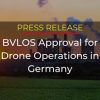The answer to this question is evolving and at a rapid pace. When the first viable commercial drones hit the market, industries initially saw only the most obvious and familiar applications, namely survey and specialty data collection that had been traditionally performed by piloted drones. As technology has advanced and costs have declined in the last decade, new use cases have emerged and been commonly adopted, expanding the number of industry roles that use aerial data solutions. Autonomous drone solutions like the Percepto solution are rapidly creating a new paradigm. By providing continuous data collection, machine learning, live streams, and archival data available in the cloud at any time from any connected device, more and more team members at industrial organizations worldwide are not only using aerial data, but relying on it on a daily basis.
Security Teams
Autonomous operations have made aerial data an indispensable tool for security teams, providing an extra set of eyes in the sky at all times. Scheduled patrols of site perimeters are routinely monitored, and on-board machine-vision automatically alerts personnel of potential threats and can track the human or vehicle to maintain awareness of the intruder’s location.
Safety Teams
Early detection of hazards used to be a labor-intensive process. Safety teams now leverage aerial data and anomaly detection (thanks to onboard machine learning) to continuously monitor site conditions for potential risks. In the event of an emergency, autonomous drones act as the first responder, providing aerial situational awareness before humans are put in harm’s way.
Operations Teams
The simple ability to see any area of a site on-demand without physically have to walk or drive there is becoming standard in day-to-day processes. Teams schedule regular aerial data collection of critical assets to perform inspections at a higher frequency than was viable with the traditional labor-intensive, manual processes. Aerial data is also used for land and coastline surveys, either pre-planned or on-demand.
Compliance Teams
Compliance teams have transitioned from passive use to more active, regular use. Teams now rely on aerial data solutions to continuously monitor sites for regulatory violations and safety hazards. Additionally, archival data has become invaluable in avoiding what in the past may have been lengthy and expensive investigations. With a complete historical record of site conditions, teams are now able to quickly validate claims and prove compliance to regulators.
Executives
In the past, executives used aerial data as the occasional substitute for a site visit. Fully autonomous solutions now make a virtual check-in of the site available at any time. For those that made an early investment in the technology and now have several years worth of historical data, advanced modeling and forecasting of production is now possible.
In Conclusion
When machine learning is applied to aerial data captured consistently at a high frequency, and data is archived for easy access in the cloud and available via live stream at any time, virtually every decision-making role on industrial sites can benefit. Percepto’s customers are among the first in the world to have access to these new insights, and with every production phase, maintenance cycle, operational need or compliance auditing, we are realizing alongside them every day the full value of aerial data on industrial sites.





